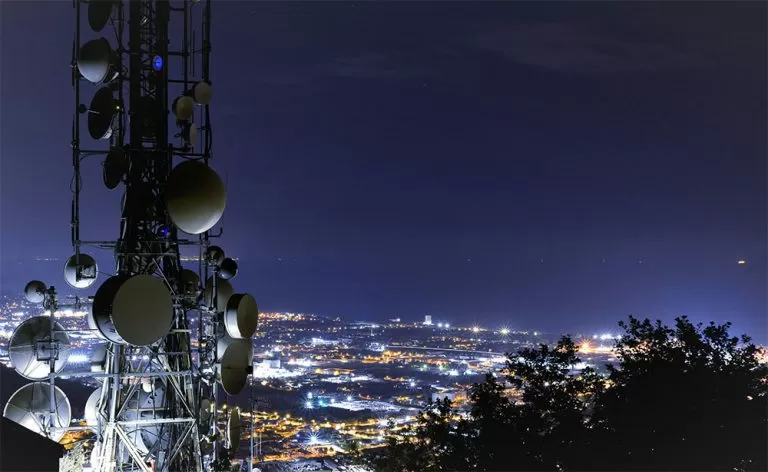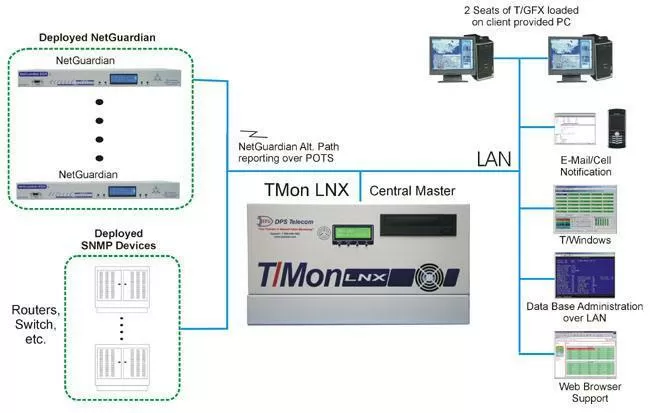Check out our White Paper Series!
A complete library of helpful advice and survival guides for every aspect of system monitoring and control.
1-800-693-0351
Have a specific question? Ask our team of expert engineers and get a specific answer!
Sign up for the next DPS Factory Training!

Whether you're new to our equipment or you've used it for years, DPS factory training is the best way to get more from your monitoring.
Reserve Your Seat Today
Very few people truly grasp the vast network that keeps the world running. People rarely see the endless telecom towers that keep us connected, each data center that supports them, or the seamlessly-connected utilities that keep our electricity flowing and water running. They don't see it, but they rely on it to run without question.
If you're in charge of a network of information technology that keeps the world moving, you know the pressure to understand everything in your network. That means you also understand the need for a remote infrastructure monitoring strategy that gives you the right information to act intelligently.
Having a solid strategy for systems integrity (and cost savings) is vital to your company's business goals.
This remote infrastructure monitoring and management strategy must include having the best technology, the most cost-effective networking system, and customized support to make it work for your needs.
Your remote infrastructure monitoring strategy is how you make that vast network small and manageable. It lets you display it on one screen. It creates an information source that people like you can rely on.
When coming up with a strategy, you need to consider a few things:
Understanding all of these can help you set in place an effective strategy and find a partner who can answer all your questions.
The first step is doing a thorough analysis of your network, your overall system, and your technology. Some of the primary things that companies like telecoms, utilities, and others with remote sites are monitoring include:
This might seem like a hodgepodge, but they are all connected. After all, having your network equipment fail is bad. It might happen because of a power surge, a spike in humidity, a vandal, or something else. So you want to monitor both the items themselves and the factors that could impact the items.
Doing all of this can help you prevent any problems. If you notice a rise in humidity, you can take action to prevent a breakdown. If you have security issues, you can automatically notify first responders. A full and thorough evaluation of all your system needs is the best way to make sure that you have full coverage and that you don't buy excessive equipment.
Other aspects to take into account include the age of your equipment and the languages used by your existing communication equipment. The cost of upgrading is something you need to consider when looking to buy remote monitoring equipment.
Before you even think about top-level management services or cloud services, you need your "boots on the ground". What infrastructure monitoring equipment will you physically have at your sites?
There are two primary kinds of top hardware monitoring tools for your remote sites.
RTUs. Remote Telemetry Units have attached physical sensors to monitor equipment and conditions at your remote location. These can be used to monitor all the elements we described above and can be customized according to your needs.

RTUs don't just measure temperatures; they send alarms if temperatures reach over a threshold you pre-determined to be dangerous. These are essentially the eyes and the ears (and nose!) of your operation.
Master stations. Master stations are the brains at the center of the network. They present the information and alarms from different types of equipment, prioritizing them on a central computer screen for your management to view. You can be alerted via email or text when something goes wrong.

Master stations like this T/Mon collect alarms from RTUs and important remote infrastructure.
There are a few exceptions to the master station rule. Some people find that you don't need one if you have fewer than 10 stations; you can just get direct emails if something happens. But every additional station means more information, which you'll be responsible for prioritizing on the fly. It's important to understand not just your system, but the capacity of your personnel.
When selecting equipment, you'll want to make sure you have a master station that can translate any legacy equipment. You might not have the budget to overhaul your entire system all at once, so in order to leave no station behind, you need an intelligent machine that understands multiple protocols. That's critical.
Other remote site best practices related to equipment include choosing durability over price and getting equipment that is easy to use. Having things break down or malfunction doesn't help you hit your primary goals of solving problems and saving money.
Here's where your system lines up with your equipment. When you are looking to set up a system, you'll want to correlate everything that can go wrong with every action it takes to rectify it. That means you'll have to do a comprehensive survey of everything you want to happen from your system. This can include:
This list may only include a few areas, but these concerns are actually very complex. Customizing remote infrastructure monitoring to automatically produce alarms will help.
There are ways to maximize uptime by automating responses without human involvement, but that's not always the case. Sometimes, the fire department has to be involved. Sometimes you need to send people to the site to fix it.
That's why prioritizing alarms matters. You don't want people going to a remote site for no reason. You want to minimize windshield time and maximize efficiency. That's vital to capturing real ROI on a project.
One result you are probably expecting is "peace of mind." Maybe "a better night's sleep," too! But those aren't really measurable (okay, maybe the second one is). What you are going to be looking for are key performance indicators that let you know if this is a good investment.
Those are some of the key performance indicators (KPIs). But the main ones are the most-easily measurable, and the most obvious to you, to regulators, managers, shareholders, and even the public:
You want 100% uptime. You'll want to avoid bad press. You need a resilient system that quickly justifies its cost. So how do you get it?
You have a strategy and probably have set goals. You have KPIs and ROI to be concerned about. So how do you make it happen?
The primary thing you need to do is find a partner you can trust. You want one with experience, who understands your needs, knows your industry, and has the equipment to set up a system you can depend on.
Ultimately, what your strategy boils down to is: how do I keep my system running? That means smart equipment, flexible solutions, custom plans, and a partner who can make it happen. It means teamwork.
Teamwork requires working together to create a remote infrastructure monitoring system you - and everyone who is relying on you - can rely on, too.
DPS Telecom has the experience and expertise to help companies implement effective remote infrastructure monitoring strategies. Our technicians can work with you to install RTUs with easy-to-use interfaces for more automatic responses. Reach out and get a quote today!
Image courtesy Shutterstock